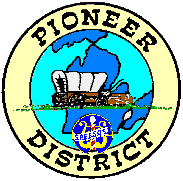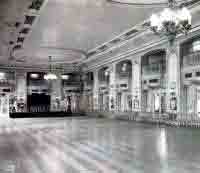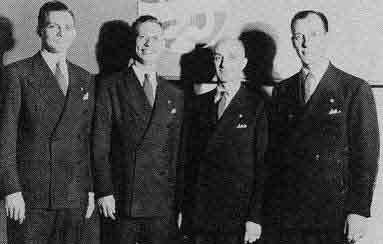



Ballroom
|

Book Cadillac
|
Detroit was awarded the 1944 midwinter meeting of the national board from a mail vote taken in November of 1943. At this meeting, the Michigan Chapters invited the Society to hold its national convention at Detroit in June of 1944. The Oakland County Chapter was chosen as the host chapter for this midwinter, and it was held at the Statler Hotel in Detroit on January 15, 1944. It was at this meeting that Detroit was selected as host for the 1944 national convention and contest, the first of four conventions to be held in this great city. That evening the delegates were entertained at the Detroit Chapter's fifth annual "Parade of Quartets" at the Book Cadillac.
 Frank P.Morse
|
The 1944 district contest was held February 19, 1944, at the large Central Campus Auditorium in Muskegon. Muskegon was the home of Frank Morse who had succeeded Joe Wolff as the district president. Other officers for 1943-44 were W. Carleton Scott, Gordon Grant, and Walter Bradley. The contest was won by the HARMONY HALLS (Ed Gaikema, Bob Hazenburg, Ray Hall, and Gordon Hall) of Grand Rapids, who had previously attained medallist status at the 1943 national contest in Chicago a few months earlier. In second place was the VETS FOUR of Kalamazoo (Herrington, Vaughn, Spicketts, and Johnson); and, in third place, the AMBASSADORS of Detroit (Scott, Marsden, Jones, and Wolff). Fourth place went to the GAY NINETIES of Kalamazoo (Rushmore, Leonard, Floyd Deem, and Donald Deem), and in fifth place was the CONTINENTALS of Muskegon (Freye, Bishop, Rex Weaver, and Peterson).
FIRST QUARTET MEDALLIONS PRESENTED:The Oakland County Chapter, in September of 1943, offered to present the first O.C. Cash Medallions to the members of the top five quartets in the 1944 national contest. In accepting the offer, National President Hal Staab wrote then OCC President Carleton Scott: "It was most magnanimous of the Oakland County Chapter to offer to furnish the twenty medallions for the members of the five top quartets at the 1944 national quartet contest. The offer is accepted. I want to extend to your chapter my personal appreciation, and know that the National Board will be extremely grateful." Oakland County also presented the medals in the 1945 and 1946 contests, after which time the international office took over the presentations. We're proud that the medals presented to the top five quartets at the international quartet contests today originated in the Pioneer District!
WE MADE THE SOCIETY TRULY INTERNATIONAL!The Society became international in name and in fact in March of 1944 when the Windsor, Ontario, Canada, Chapter was organized. Sponsorship of the chapter was a joint venture of the Oakland County Chapter and the Detroit #1 Chapter, and the facts of this sponsorship were related in the August–September 1988 issue of Pioneer District Troubadour, the story of which is related below. At any rate, the Canadians took to barbershopping with great enthusiasm and immediately started organizing other chapters in the area. When the Ontario District was organized, Windsor became part of that district; but their inter-society activities remained tied more to Michigan than Ontario and, on their own petition, Windsor became a part of the Michigan District in 1958. This arrangement has worked out well for this chapter, and the district has benefited by having this fine group of barbershoppers associated with it.
WHICH CHAPTER SPONSORED WINDSOR?One question which has continued to surface historically over the past several years is one that has many answers, depending upon with whom you speak to about it. As a former member of the Oakland County Chapter, and as editor of the OCC bulletin Spotlight back in the years 1970 through 1973, it was my privilege to have corresponded with Carroll P. Adams, the founder of the Oakland County Chapter. He had somehow received a copy of my bulletin and promptly wrote to me on April 6, 1972. The following is an excerpt from that letter:
Hal Staab was elected national president and I national secretary in June of 1942. I previously had been national vice president, also national president. (Hal and I had grown up together in Northampton, Massachusetts, from 1903 to 1911.) Our titles did not become international until the night in early 1944 when OCC sponsored the Windsor, Ontario chapter." [Underlining added.]
After receiving that letter, I talked with several of the old timers in our chapter, and they confirmed to me orally that Oakland County did, in fact, sponsor Windsor. One former member with whom I had spoke was W. Carleton Scott, who was chapter president in 1944 and was a reliable source.
It never really entered my mind that members of the Detroit #1 Chapter felt that they had sponsored Windsor. Doran McTaggart indicated the same to me at a Windsor Send-Off Show; and when I queried him about it later, he stated that Detroit did sponsor them and that he had a plaque to prove it. Questioning him further, I found that the plaque had been given to the Windsor Chapter six or seven years prior to that conversation by the Detroit Chapter; and it was his sole reason for thinking that Detroit #1 had sponsored Windsor. He had no other facts or information.
The following year, your author became the Pioneer District historian. As such, I came into a complete backlog of Harmonizers and district Troubadours. I completed filing all of these by year, beginning with the Rechordings published in 1941 and found some very interesting information pertaining to this very question. In the September 1943 Harmonizer, I found the following excerpt in an item accompanying the article concerning the presentation of the O.C. Cash quartet medals by the Oakland County Chapter, as follows: "Oakland County has laid plans to sponsor a chapter in Plymouth, Michigan, and one in Windsor, Ontario. When the latter becomes a reality, our Society will, for the first time, be truly `International'."
Continuing my research, I uncovered the following article in the March 1944 issue of the Harmonizer:
HERE'S REAL INTER-CHAPTER COOPERATION:
As an example of being good neighbors, here's one for the book. The fourteen members of the executive committee of the Detroit (Michigan No. 1) Chapter are all active members of the Oakland County (Michigan No. 9) Chapter. And the eleven members of the Oakland County Executive Committee are all active members of the Detroit Chapter. Such collaboration is sure to be valuable in the staging of the 1944 national contest and conference in Detroit, June 15, 16, 17.
I think you can begin to see the conclusion that your author is reaching already. In the advance bulletin for the 1944 convention, (it wasn't dated, but I assume it to be about April of 1944) the following article appeared, and I excerpt it for your perusal:
WELCOME CANADA
With the chartering of the Windsor, Ontario, Canada Chapter, SPEBSQSA becomes an international organization. Detroit and the Oakland County chapters share equally the credit for this latest, and important, addition to our roster of chapters. With plans underway for several other Canadian chapters, it begins to look as though Owen Cash's brainchild knows no limits.
Duane Mosier, who was the Pioneer District historian in 1970, indicated the same thing, although I suspect he was quoting the same article I referred to above. In the March-April 1972 issue of the Harmonizer, Carroll Adams published a column called "Reminiscing," and in this article he reiterated that Windsor was sponsored by the Oakland County Chapter.
The issue probably will never be resolved, since most of the veteran barbershoppers of that era are no longer with us. However, since Carroll Adams was the national secretary at that time and Oakland County was his home chapter in 1944, your author feels that his word should be final. It may be that the Oakland County Chapter was the official sponsor, and that both chapters contributed substantially. Who knows? One thing is for sure—If anyone asks you who sponsored Windsor on March 24, 1944, you can answer safely with "Detroit-Oakland," and you'll be right, since these two great chapters merged in 1986 and is now one chapter.
FIRST INTERNATIONAL CONTEST AND CONVENTION HELD IN DETROITThe 1944 international contest and convention was held in Detroit June 15-17, and again the Michigan District can be extremely proud in that it provided the manpower and know-how to make this an outstanding contest.

HARMONY HALLS
|
Michigan men elected to international offices at this convention included, as follows: Carroll Adams, executive secretary; W. Carleton Scott, master of ceremonies; Thurlo G. "Red" Masters and Edward D. Sperry, board of directors. First place Achievement Awards went to Muskegon in Population Group No. 2 and to Oakland County in Population Group No. 3. [There were four population groups at this time, arrived at by the total population of the city where the chapter is located. How things have changed!].
FIRST SOCIETY LOGO:The story behind the design of our Society Logo is quite interesting. Dick Sturgis, the official Harmonizer art editor at the time, gave this interpretation of the development of the Logo in the March 1944 issue of the Harmonizer. "In the spring of 1942, Charles Cimerro, Atlanta Chapter member, suggested to me a design for a Society emblem, based on a barber pole, with a lyre in the background, and the Society's initials in a ribbon across both. In the fall of 1943, Joe Wolff, national board member, submitted a design showing a barber pole, superimposed on a lyre, all contained in a circle. Then I, Dick Sturgis, who never had an original idea in my life, in my best kleptomaniac manner, stole both ideas, combined them, and hornswoggled the National Board into accepting my design as a new lapel emblem."
A somewhat different version appeared in Joe Wolff's reminiscences published in 1968, as follows: "As to our Society's emblem, I merely wish to say I designed it, showing a red and white striped barber pole interposed upon a gold lyre against a dark blue background. I forwarded it to Carroll Adams and he, in turn, referred it to the Board of Directors. The Board then asked Jim Sturgis [should have been Dick], the old time wood-shedder, to put a white band with SPEBSQSA on it and place it across the front of the design, and that was the end of it."
Looking back on this whole scenario from an historian's vantage point, I think it can be safely said that the design of the logo was a joint venture, and that all participants can be designated co-designers. After all, who is around to dispute it?
AND WE ENTERTAINED THE TROOPS:During the war years of 1942 through 1945, it must be pointed out that the quartets of the Michigan District performed virtually at the "drop of a hat" for the U.S.O. and the many veteran hospitals in the area; and they were well-liked by the many veterans for whom they sang. Dorothy D. W. Coolidge, who was in charge of the Entertainment Committee for the Detroit U.S.O. stated, "May I say in closing that I have heard barbershop quartets sing all my life in amateur and professional capacities. But I have never before heard the emotional quality the quartets produce when they sing for our armed forces. As the electric vibration is set up between audience and quartet, the performance of these singers often takes on a rare quality of sincerity and enthusiasm. ... it brings 20 to 500 service men and women as the audience may be whose hearts are warmed and whose spirits have been refreshed for a time just as have those of the men who have worked in the quartet. It can be a thrilling experience."Once again, the district can be justly proud of our predecessors who did so much at a time when they were needed".
| [index] | [1940] | [1941] | [1942] | [1943] | [1944] | [1945] | [Contents] |